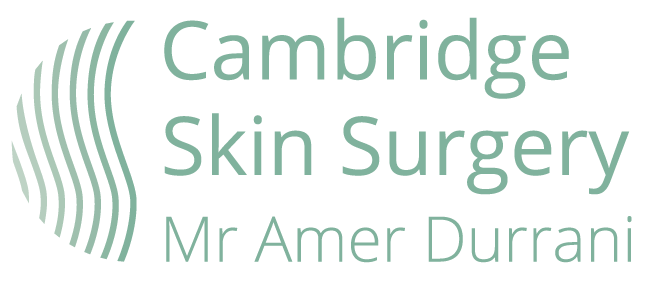Mr Durrani works closely with a Mohs Surgeon, and will undertake your reconstruction once your tumour has been removed.
What is Mohs Surgery?
Mohs surgery is a precise surgical technique used to treat certain skin cancers, such as BCCs in difficult anatomical areas (e.g. around the eyes, nose or mouth), recurrent BCC and infiltrative BCCs.
During Mohs surgery, thin layers of cancer-containing skin are progressively removed and examined until only cancer-free tissue remains. Mohs surgery is also known as Mohs micrographic surgery.
The goal of Mohs surgery is to remove as much of the skin cancer as possible, while doing minimal damage to surrounding healthy tissue. Mohs surgery is usually done on an outpatient basis using a local anesthetic.
Mohs surgery is an improvement to standard surgery (local excision), which involves removing the visible cancer and a small margin of surrounding healthy tissue all at once. Mohs surgery allows surgeons to verify that all cancer cells have been removed at the time of surgery. This increases the chance of a cure and reduces the need for additional treatments or additional surgery.

The Mohs Team
The team consists of the Mohs surgeon, Mr Durrani (the reconstructive surgeon), a histology technician and assisting nurses. The extent of the skin cancer is identified and its margin, using a dermatoscope. The cancer is removed under local anaesthetic and prepared for histology processing. This is accomplished by cutting the specimen, marking the specimen for orientation, and sending it to the laboratory.
The histology technician prepares the tissue for Mohs processing by flattening the surgical margin on a flat surface first. Then the flat surgical surface is mounted on a cryostat to be sectioned and prepared for glass slides to be read by the pathologist.
In Mohs surgery, the surgeon acts as the pathologist. He or she examines the slide for residual tumour, and marks the location of the tumour on the pathology report.
The Mohs surgeon and Plastic surgeon (Mr Durrani) reconstruct as a team, and studies show that the reconstructive options are greater when the Mohs surgeon and Plastic surgeon reconstruct defects together.
What to expect from Mohs Surgery
Mohs surgery is performed on an outpatient basis in an operating room that has an adjacent laboratory that allows the dermatopathologist to examine the tissue after it’s removed.
In most cases, the procedure lasts a few hours. But since it can be difficult to tell how extensive a skin tumour is just by looking at its surface, doctors often advise reserving the whole day for the procedure.
To prepare you for surgery, your surgeon cleans the area to be operated on, outlines it with a special marker pen and injects the area with local anaesthetic. The anaesthetic numbs the skin, so you won’t feel any discomfort during the procedure.
Post Procedure
After all of the skin cancer has been removed, Mr Durrani will confirm how to reconstruct the wound. Depending on the extent of the area of tissue removed, this might include:
- Letting the wound heal on its own (healing by second intention)
- Using stitches to close the wound (primary closure)
- Moving skin from an adjacent area (skin flap) to cover the wound
- Using a skin graft from another part of the body, such as in front of the ear, to cover the wound
Instant Results
One of the advantages of Mohs surgery is that you know your results right away, and you usually don’t leave your appointment until all of the skin cancer has been removed. You will have a follow-up visit with Mr Durrani to monitor your recovery to make sure that your wound is healing properly.
